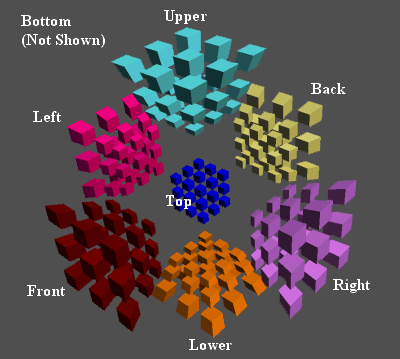Difference between revisions of "Notation"
(→Uncommon/old Notations:) |
|||
| Line 24: | Line 24: | ||
===Experimental Notations:=== | ===Experimental Notations:=== | ||
| − | '''Blob Notation:''' | + | |
| − | <br> | + | '''Blob Notation:''' <br> |
| − | ''' | + | Blob Notation was an attempt by Blobinati Cuber to make Zhao Notation more efficient by making each of the 13 symmetries of a cube into a letter (a-m) following the main 8 letters that represent the cells. <br> |
| + | a, b, & c were y, x, & z rotations, and the rest were various corner and edge twists. <br> | ||
| + | This notation does succeed in making corner and edge twist moves take up less letters to write, at the cost of having to memorize 13 new letters and what their moves look like. <br> | ||
| + | |||
| + | '''Picture Notation''' | ||
===Uncommon/old Notations:=== | ===Uncommon/old Notations:=== | ||
Revision as of 20:07, 26 August 2021
Contents
n^4:
Commonly Used Notations:
Zhao Notation:
The notation is similar to that of the 3^3. There are 8 cells, six of them using the same letters as that in the 3^3: U (up), D (down), F (front), B (back), R (right), L (left). The near cell which is not visible, is named K, for kata. The far cell, which appears as the innermost cell, is named T, for top. (Thanks to Neodam22 for pointing out the problem!) Its name was changed from A to T since ana and kata are easier to confuse with each other than kata and "top".
Each cell in turn uses WCA Official Notation (standard notation).
The first letter determines the cell to click on. The second letter determines the sticker on the cell (is usually a 2C piece) to click on For example:
RK means to click the sticker on the right cell that joins to the near cell.
TF means to click the sticker on the far cell that joins to the front cell.
FT means to click the sticker on the front cell that joins to the far cell.
To state a set of all possible turns (clicks) of a cell, X- is used. For example: R- includes RU, RF, RD, RB, RT, and RK.
To state a set of all possible turns (clicks) of cells that are joined to the original sticker to be clicked, -X is used. For example, -R includes UR, FR, DR and BR, TR and KR.
Slice and wide turns can be notated with the 2c piece that you click on, plus the number you hold down to perform that move. For example, 2RK is like an M', and 12RK is like Rw'.
I/O variant of Zhao Notation
Some people in the community prefer to use I (Inner) instead of T, and O (Outer) instead of K.
This makes it more obvious which face is which, whereas "Top" can be confused with Up
Rotation Notation:
Rotation Notation uses the same cell names from Zhao's Notation, but uses 3^3 x, y, and z rotations to be more intuitive.
Each turn is made up of the face you click in followed by which rotation that face undergoes.
If you wanted to make the F face of the T cell become the U face of the T cell, that would be Tx because it's rotating the T cell clockwise along the x axis.
One of the downsides of this notation is that edge and corner twist moves become longer. For example: T[UF] becomes Tz2x.
Experimental Notations:
Blob Notation:
Blob Notation was an attempt by Blobinati Cuber to make Zhao Notation more efficient by making each of the 13 symmetries of a cube into a letter (a-m) following the main 8 letters that represent the cells.
a, b, & c were y, x, & z rotations, and the rest were various corner and edge twists.
This notation does succeed in making corner and edge twist moves take up less letters to write, at the cost of having to memorize 13 new letters and what their moves look like.
Picture Notation
Uncommon/old Notations:
Roice Notation:
Roice's Notation uses different names for the cells.

Each cell's stickers are numbered from 1-27 on the 3^3, and after that you state whether you performed a left or right click.